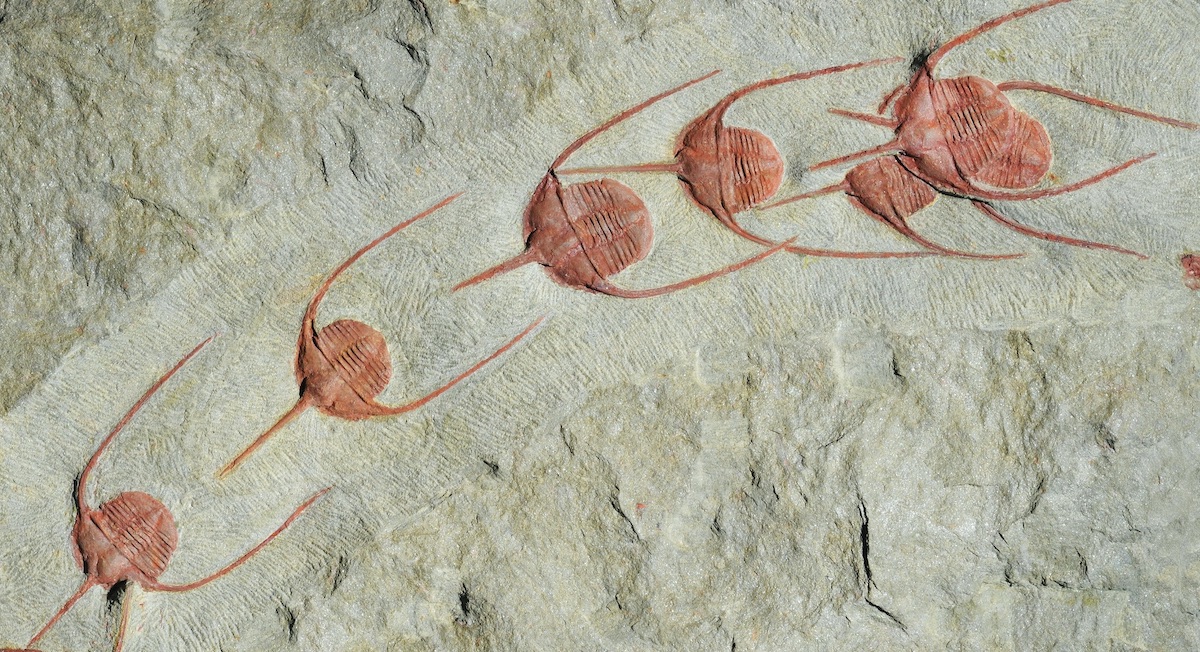 Evolution & Behaviour
Evolution & Behaviour
Processions in Palaeozoic seas
Collective behavior is common among present-day animals. Exceptional fossils from Morocco - trilobites lined-up in single files and facing the same direction - suggest collective migrations date back to at least 480 million years ago.

What do ants, processionary caterpillars, birds, apes and football supporters have in common? They all exemplify the huge variety of present-day collective and social behaviours. One of the questions puzzling scientists is whether collective behaviour appeared very early in the evolution of animals or more recently. Our results indicate that animals probably started to engage in group behaviour already nearly half a billion years ago.
Evidence comes from the arid regions of southern Morocco near Zagora, where exceptional fossil sites shed light on an ancient burst of animal diversity that took place in Paleozoic some 480 million years ago. This is precisely where we have been doing fieldwork in close collaboration with colleagues from the Cadi-Ayyad University, in Marrakesh. The rocks known as the Fezouata Shale contain the remains of a great variety of marine animals including the most iconic inhabitants of the Palaeozoic seas: trilobites. Fezouata trilobites are often found in single files with individuals amazingly facing the same direction. These trilobites belong to a species called Ampyx priscus, characterized by extremely long side and front spines (shown in the picture above).
Fossils generally give us a picture of the external shape or skeleton of ancient animals, but rarely provide direct information on their behaviour. Understanding these puzzling processions required detailed analyses of the fossils themselves, but also of the geological setting and the surrounding sediment in which trilobites were entombed. We needed to determine whether these alignments preserved the natural posture and behaviour of trilobites just before they died or formed after, for example by transport and rearrangement of fossils by water currents. The consistent orientation of these trilobites and the fact that virtually all individuals belonged to the same species clearly favoured the second hypothesis.
In parallel, geological studies suggested that trilobites were suddenly killed and entombed on site by sediment deposited during a storm. Not surprising given that Morocco was situated quite close to the South Pole during that period, and therefore exposed to harsh meteorological conditions.
There remained the puzzling question of why these trilobites gathered together. Answers came when we compared them with present-day marine animals such a spiny lobsters from the Bahamas area. These lobsters perform single-file migrations when seasonal storms churn and cool down water disturbing their environment. Their processions strongly recall the linear clusters observed for our trilobites and storms, in both cases, are likely to have been the main trigger of collective migrations. Spiny lobsters rely on tactile contacts between individuals' antennae to coordinate movement in groups. The long spines of Ampyx might have played a similar role.
But what is the advantage of travelling in groups? According to biologists migration in groups distorts the visual perception of predators and hence reduces the probability they will attack. Since our trilobites had potential predators, their collective behaviour may have enhanced their chances of survival. We also explored alternative options. Numerous present-day animals migrate in groups for seasonal reproduction at spawning grounds. For example, modern horseshoe crabs, gather along the shore in large numbers for mating. This behaviour is synchronized through both visual and chemical (pheromone) communication. Our trilobite clusters that consist of adult, presumably sexually mature, individuals may have resulted from a similar reproduction behaviour.
The mystery of Ampyx processions cannot be entirely resolved but two plausible scenario seem to prevail: trilobites travelled in group for vital reasons, either to escape environmental stress or to reproduce, keeping in mind that these options are not mutually exclusive. Whatever the reason, the collective behaviour of Ampyx would not have been possible without a communication system between individuals. Since Ampyx had no eyes, it must have been able to detect and process chemical and tactile signals, for example via its long spines.
Our study shows that collective behaviour originated a long time ago when animal life started to bloom and diversify. Is this the oldest record? Probably not. Another case of enigmatic collective behaviour has been reported in shrimp-like animals from the ca 520 million-year-old Chengjiang fauna. Their chain-like assemblages observed on rock slabs strongly recall the migratory queues of processionary caterpillars or ants, but have been interpreted as being formed in a water column. This questionable interpretation definitely needs more detailed studies and is part of our future projects.
Original Article:
Vannier J, Vidal M, Marchant R et al. Collective behaviour in 480-million-year-old trilobite arthropods from Morocco. Sci Rep. 2019;9(1).Edited by:
Dr. Beata Kusmider , Managing Editor
We thought you might like
More from Evolution & Behaviour
Rudimentary form of syntax present in chimpanzees
Nov 29, 2023 in Evolution & Behaviour | 3 min read by Maël LerouxAn incredibly massive ancient whale skeleton reveals a new way to become a giant
Nov 27, 2023 in Evolution & Behaviour | 4 min read by Olivier LambertVikings and Migrants: Unravelling Scandinavia's Genetic Mosaic in the Viking Era
Nov 13, 2023 in Evolution & Behaviour | 3 min read by Anders Götherström , Ricardo Rodríguez VarelaFish identify themselves in mirrors and portraits
Oct 18, 2023 in Evolution & Behaviour | 3.5 min read by Masanori Kohda , Satoshi Awata , Shumpei SogawaEditor's picks
Trending now
Popular topics


